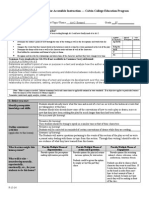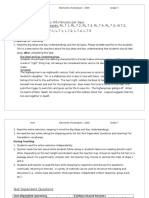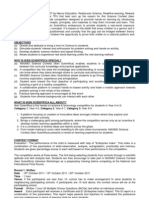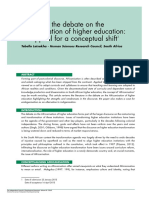Homeless Bird, Lesson 1
Homeless Bird, Lesson 1
Uploaded by
sarahCopyright:
Available Formats
Homeless Bird, Lesson 1
Homeless Bird, Lesson 1
Uploaded by
sarahOriginal Description:
Copyright
Available Formats
Share this document
Did you find this document useful?
Is this content inappropriate?
Copyright:
Available Formats
Homeless Bird, Lesson 1
Homeless Bird, Lesson 1
Uploaded by
sarahCopyright:
Available Formats
1
CCSU Lesson Plan
Template
Student Teacher: Sarah Schoenborn
Grade Level: 5
Lesson Date:10/22/15
Name of Lesson: Homeless Bird introduction
Common Core State Standard(s)
CCSS.ELA-LITERACY.RL.5.1
Quote accurately from a text when explaining what the text says explicitly and when drawing
inferences from the text.
CCSS.ELA-LITERACY.RL.5.2
Determine a theme of a story, drama, or poem from details in the text, including how characters in
a story or drama respond to challenges or how the speaker in a poem reflects upon a topic;
summarize the text.
CCSS.ELA-LITERACY.W.5.1.C
Link opinion and reasons using words, phrases, and clauses (e.g., consequently, specifically).
Student Learning Objective(s)
Students will be able to identify the main characters in the first three chapters of the book as well
identify the setting of the story. Students will also be able to use direct quotes from the text to
support their opinions, and make predictions as to what will happen next in the book.
lessons objective.
This lesson will help students learn to identify the major characters, theme, and setting of the story.
Also the students will learn the importance of using the text (in direct quotes) to make inferences
and predictions as to what is going to happen next in the story.
Rationale for Objective: How does this lesson support previous and subsequent learning?
This lesson will allow students to pick out the important details (theme, setting, and characters) of
a piece of literature. This will allow them to analyze literature more critically as well as making
predictions using support from the text. Students have been taught previously the correct way to
cite novels.
Assessment
Students will be assessed on their ability to use direct quotes from the text in order to support their
predictions. Students will also be assessed on their ability to answer basic questions that identify
the setting, theme and main characters.
Instructional Model/Strategy
The lesson will begin by having the students listen to the first three chapters read aloud in class.
Then the students will be placed in groups to complete the ED TED assignment. The students
1
will then respond to the Padlet activity individually. After the padlet activity is complete the
class will engage in a brief whole group discussion about the prediction responses. The students
will then work in groups of 2 to create a Fakebook page for one character that has been in the
book so far (chapters 1-3).
Materials/Resources needed for this lesson
Smartboard
Ipads/computers
Copies of Homeless Bird
Daily formative assessment:
The teacher will walk around as the students are viewing the ED TED video and help them if they
have any questions. Also the teacher will read their padlet response and discuss with the group as a
whole whether or not they accurately used direct citations to support their predictions.
Differentiating Instruction:
The first three chapters will be read aloud so difficult vocabulary or content can be addressed by
the teacher as the story is read. Students will be working in small groups when viewing the ED
TED video to help guide them through the exercises. Also the teacher will be walking around and
providing scaffolded instruction as the students complete their Padlet responses. The whole group
discussion that follows the Padlet activity will also help clear up any misunderstandings of how to
directly quote from a text as well as using text as support for argumentation/predictions.
Initiation:
The teacher will start the lesson by having the students listen to the first three chapters of Homeless
Bird by Gloria Whelan read aloud. The teacher will address any difficult vocabulary or content
and then ask the students to get into groups of 4 to watch the ED TED video, and answer the
corresponding questions on their Ipads (one per group).
Lesson Development:
Once the students have completed watching and responding to the ED TED video, they will
individually respond to the Padlet activity that is displayed on the Smartboard. Students will use
direct citations from the novel to write brief predictions using two specific examples from the text
of whether Sass, Sassur, or Chandra (they get to pick one) will have a positive or negative impact
on Kolys experiences during the rest of the book. As the students are responding to the padlet
activity the teacher will be walking around and helping students remember how to accurately cite
a novel, and answer any questions they might have. The teacher will then hold a small group
discussion once everyone is finished responding to the Padlet. The small group discussion will go
over whether or not people have cited the text accurately and whether or not their classmates agree
with the predictions that have been made.
Closure:
The teacher will then have the students get into pairs and create a Fakebook page for
one of the characters (of their choosing from the first three chapters). The students
2
will have to exhibit their knowledge of setting, theme and main characters with the
details they choose to include in their Fakebook pages. Once the students are done
completing this lesson they should have a thorough grasp of how to identify the
setting, theme, main characters (from homeless bird, which they can then apply to
any story) and how to directly cite a novel to make predictions.
Tech resources:
http://ed.ted.com/on/pyDBeslh
http://www.classtools.net/FB/1041-8nhAFg
http://padlet.com/sschoenborn5/dqg23jfgs0w6
You might also like
- Lesson Plans - Edtpa VersionDocument14 pagesLesson Plans - Edtpa Versionapi-409940614No ratings yet
- Willy The Wimp LessonDocument3 pagesWilly The Wimp Lessonapi-286280425No ratings yet
- HRGP DLL Week 4Document5 pagesHRGP DLL Week 4Rebecca Parial100% (1)
- Emma M - Roberts Lesson Plan Template 1Document3 pagesEmma M - Roberts Lesson Plan Template 1api-312742046No ratings yet
- 2 Unit Plan Overview DraftDocument4 pages2 Unit Plan Overview Draftapi-213547236No ratings yet
- Metaphorical Expression Lesson PlansDocument3 pagesMetaphorical Expression Lesson Plansapi-359783311100% (1)
- Lesson On Political PoetryDocument2 pagesLesson On Political PoetryFl HaineNo ratings yet
- Ubd Final DraftDocument8 pagesUbd Final Draftapi-289742240No ratings yet
- Siop Lesson PlanDocument2 pagesSiop Lesson Planapi-445759289No ratings yet
- Lesson Number FiveDocument3 pagesLesson Number Fiveapi-284181679No ratings yet
- Lesson Plan 2 Homeless BirdDocument3 pagesLesson Plan 2 Homeless BirdsarahNo ratings yet
- Poetry UnitDocument15 pagesPoetry Unitapi-531843492No ratings yet
- Big Ideas: Seton Hill University Lesson Plan Template Name Subject Grade Level Date/DurationDocument5 pagesBig Ideas: Seton Hill University Lesson Plan Template Name Subject Grade Level Date/Durationapi-279917116No ratings yet
- 7 AnneFrankTheDiaryofaYoungGirl PDFDocument46 pages7 AnneFrankTheDiaryofaYoungGirl PDFDesiree Espinoza100% (1)
- Poetry in Ubd FormatDocument7 pagesPoetry in Ubd Formatapi-267445217No ratings yet
- Native American Unit Plan Grade 3Document34 pagesNative American Unit Plan Grade 3Leisl JohnsonNo ratings yet
- Curriculum Plan For British Literature - ChsDocument7 pagesCurriculum Plan For British Literature - Chsapi-242782125No ratings yet
- Final Poetry Unit For CapstoneDocument15 pagesFinal Poetry Unit For Capstoneapi-317553481No ratings yet
- Lesson PlansDocument12 pagesLesson Plansapi-277926200100% (1)
- Y7 Narrative Writing SowDocument8 pagesY7 Narrative Writing SowMustafa Al QadyNo ratings yet
- Siop Poetry Lesson PlanDocument2 pagesSiop Poetry Lesson Planapi-235090833No ratings yet
- Big Ideas Essential Questions: Seton Hill University Lesson Plan Template Name Subject Grade Level Date/DurationDocument4 pagesBig Ideas Essential Questions: Seton Hill University Lesson Plan Template Name Subject Grade Level Date/Durationapi-266477631No ratings yet
- Poetry UnitDocument3 pagesPoetry Unitapi-251530394No ratings yet
- I Want A WifeDocument3 pagesI Want A WifeBianca Fasciani100% (1)
- Course Syllabus Aa ReadingDocument9 pagesCourse Syllabus Aa Readingapi-297204727No ratings yet
- Subject English Language Arts Grade 10-2 Topic/Theme Poetry & Short Stories Length (Days) 28Document28 pagesSubject English Language Arts Grade 10-2 Topic/Theme Poetry & Short Stories Length (Days) 28api-340960709No ratings yet
- English 4C - Independent Study Outline: These Dates Are Subject To ChangeDocument6 pagesEnglish 4C - Independent Study Outline: These Dates Are Subject To Changeapi-476730596No ratings yet
- Read Clinical LessonDocument2 pagesRead Clinical Lessonapi-251810764No ratings yet
- Syllabus - 2014 Poetry Yr56Document16 pagesSyllabus - 2014 Poetry Yr56api-269195117No ratings yet
- Mini Thematic Unit - Pre-KindergartenDocument36 pagesMini Thematic Unit - Pre-Kindergartenapi-257946648No ratings yet
- 1984 Calendar Unit PlanDocument6 pages1984 Calendar Unit Planapi-200442480No ratings yet
- 11simon Mah Macbeth Unit Plan PDFDocument29 pages11simon Mah Macbeth Unit Plan PDFMarxus NexusNo ratings yet
- Unit Plan For Opinion Writing 3rd GradeDocument23 pagesUnit Plan For Opinion Writing 3rd Gradeapi-249867232No ratings yet
- Glencoe British Literature Reader's Choice Unit 5 Lesson PlanDocument12 pagesGlencoe British Literature Reader's Choice Unit 5 Lesson PlanDawid FourieNo ratings yet
- CCGPS 6ELA Pacing Gude With Addendum and Unwrapped Power StandardsDocument47 pagesCCGPS 6ELA Pacing Gude With Addendum and Unwrapped Power StandardsFlorinNo ratings yet
- Ela Lesson PlanDocument4 pagesEla Lesson Planapi-486161267100% (1)
- Digital Unit Plan TemplateDocument4 pagesDigital Unit Plan Templateapi-239241893No ratings yet
- Metamorphosis Lesson Plan Notice and NoteDocument3 pagesMetamorphosis Lesson Plan Notice and Notetwilli98No ratings yet
- Interview A ClassmateDocument2 pagesInterview A Classmateapi-264112842No ratings yet
- Noveling 101 UnitDocument22 pagesNoveling 101 Unit000767067No ratings yet
- Eng3u Course Outline Template Eng3uDocument3 pagesEng3u Course Outline Template Eng3uapi-243678431No ratings yet
- 11.5 Historical and NonfictionDocument5 pages11.5 Historical and NonfictionMarilu Velazquez Martinez100% (1)
- Vygotsky TheoryDocument3 pagesVygotsky TheorymelianaeclsNo ratings yet
- Grade 9 Ela Curriculum MapDocument22 pagesGrade 9 Ela Curriculum Mapapi-320980022No ratings yet
- Literature Circle LessonsDocument3 pagesLiterature Circle Lessonsapi-323099162No ratings yet
- Reading Response Questions For ComprenensionDocument85 pagesReading Response Questions For ComprenensionNicole SchabenNo ratings yet
- Book Report ProjectDocument2 pagesBook Report ProjectkmschaunceyNo ratings yet
- Direct Instruction Lesson PlanDocument2 pagesDirect Instruction Lesson Planmbatalis1894No ratings yet
- Eng3u Short Stories Essay of ComparisonDocument2 pagesEng3u Short Stories Essay of Comparisonapi-241047325100% (1)
- 16-17 Hembree 10th SyllabusDocument2 pages16-17 Hembree 10th SyllabusAnonymous 5b6Y8GcCwNo ratings yet
- Eld 307 - The Perfect Pet Lesson PlanDocument2 pagesEld 307 - The Perfect Pet Lesson Planapi-250081618No ratings yet
- The Highway Man. Lesson - AnthologyDocument11 pagesThe Highway Man. Lesson - AnthologyJordan Hugh SamNo ratings yet
- The Odyssey Response To Literature EssayDocument2 pagesThe Odyssey Response To Literature EssayChris BrownNo ratings yet
- 8th Grade Honors ELA Into Letter and SyllabusDocument12 pages8th Grade Honors ELA Into Letter and Syllabuserin_garry7878100% (1)
- Rhetorical Precis TemplateDocument3 pagesRhetorical Precis TemplatestefanielcarterNo ratings yet
- Mla 8 Edition Quick Reference: NG Headi Ing Head RunnDocument12 pagesMla 8 Edition Quick Reference: NG Headi Ing Head RunnPiyusha AmbradkarNo ratings yet
- Comprehension Compare-ContrastDocument4 pagesComprehension Compare-Contrastapi-241275850No ratings yet
- Windows Notes Lesson PlansDocument4 pagesWindows Notes Lesson Plansapi-359783311100% (1)
- Jim Burke Lesson Plan Template 1Document2 pagesJim Burke Lesson Plan Template 1api-567215038No ratings yet
- No Mistakes Grammar Bites Volume XIV, "Superlatives and How We Use them Wrong"From EverandNo Mistakes Grammar Bites Volume XIV, "Superlatives and How We Use them Wrong"No ratings yet
- EDT 415 Lesson PlanDocument2 pagesEDT 415 Lesson PlansarahNo ratings yet
- How I Became A Pirate: Lesson PlanDocument4 pagesHow I Became A Pirate: Lesson PlansarahNo ratings yet
- StatesDocument2 pagesStatessarahNo ratings yet
- EDT Math LessonDocument4 pagesEDT Math LessonsarahNo ratings yet
- Introduction To MASMO Science Contest - EnglishDocument3 pagesIntroduction To MASMO Science Contest - EnglishKang Wenn LeeNo ratings yet
- Analytic Rubric TemplateDocument1 pageAnalytic Rubric TemplateJenny FontillasNo ratings yet
- Tec 516 - Suzana Tran-Iste Outline and ReflectionDocument6 pagesTec 516 - Suzana Tran-Iste Outline and Reflectionapi-413658727No ratings yet
- Persons and CareersDocument16 pagesPersons and CareersChrislyn Tisbe100% (4)
- Pointers For AssessmentDocument9 pagesPointers For AssessmentErnestoNo ratings yet
- T Letsheka Jitl1 v8 A2Document14 pagesT Letsheka Jitl1 v8 A2Ash KennyNo ratings yet
- Training Activity Matrix in Food ProcessingDocument4 pagesTraining Activity Matrix in Food Processingian_herbas100% (1)
- MODUL2 Assessment of Learrning 2 Copy 2Document9 pagesMODUL2 Assessment of Learrning 2 Copy 2Lovely Faith UmambacNo ratings yet
- Sports - Fundamentals of Coaching CG PDFDocument3 pagesSports - Fundamentals of Coaching CG PDFMarilou Tubig100% (1)
- 2019 Kirkova-Naskova JFL SecondlanguagepronetcDocument19 pages2019 Kirkova-Naskova JFL SecondlanguagepronetcLorena ValdezNo ratings yet
- Teaching English To ChildrenDocument3 pagesTeaching English To ChildrenMustafa TürkerNo ratings yet
- Students' Positive and Negative Experiences in Hybrid and Online ClassesDocument8 pagesStudents' Positive and Negative Experiences in Hybrid and Online ClassesStefanie Rose DomingoNo ratings yet
- Micro Lab Protocol LessonDocument3 pagesMicro Lab Protocol Lessonapi-491086227No ratings yet
- Aspect of SelfDocument17 pagesAspect of SelfJeon NicaNo ratings yet
- Report 9:: Types Characteristics & Identification of Learners With Difficulty Remembering & FocusingDocument18 pagesReport 9:: Types Characteristics & Identification of Learners With Difficulty Remembering & FocusingRalph Raymond Cervantes100% (1)
- Material Evaluation Form - Drawing From AAAS "Curriculum Materials Analysis Procedure"Document3 pagesMaterial Evaluation Form - Drawing From AAAS "Curriculum Materials Analysis Procedure"Jeffrey TanNo ratings yet
- Social Cognitive Framework: Organizational BehaviorDocument13 pagesSocial Cognitive Framework: Organizational BehaviorAmisha PandyaNo ratings yet
- Mission Statement: College Orientation Program and Activities Related TheretoDocument5 pagesMission Statement: College Orientation Program and Activities Related Theretodiona macasaquitNo ratings yet
- Contemporary ELT MethodsDocument14 pagesContemporary ELT MethodsaidaNo ratings yet
- Learning Delivery Modalities Course: For TeachersDocument20 pagesLearning Delivery Modalities Course: For TeachersRo Esgue50% (2)
- Leaders Are Not Born They Were MadeDocument11 pagesLeaders Are Not Born They Were MadeJoel A. SarzaNo ratings yet
- Leiva - C - How Principals Identify Lowperforming Teachers in Public Schools Evidence From ChileDocument22 pagesLeiva - C - How Principals Identify Lowperforming Teachers in Public Schools Evidence From ChilecarolinaNo ratings yet
- Arnis ModuleDocument5 pagesArnis ModuleYumyum AkoNo ratings yet
- Your Interview: Coming To RavensbourneDocument12 pagesYour Interview: Coming To RavensbournelisaconnollyNo ratings yet
- Review of Related LiteratureDocument3 pagesReview of Related LiteratureaspembraidaNo ratings yet
- Reflection Paper Medical Ward - RLE Group 7 Guide QuestionsDocument2 pagesReflection Paper Medical Ward - RLE Group 7 Guide Questionssenyorakath100% (1)
- The Engineering Capstone Course Fundamentals For Students and Instructors 1st Edition Harvey F. Hoffman (Auth.) Ebook All Chapters PDFDocument62 pagesThe Engineering Capstone Course Fundamentals For Students and Instructors 1st Edition Harvey F. Hoffman (Auth.) Ebook All Chapters PDFmridulsiyala100% (3)
- MNISTDocument3 pagesMNISTanushajNo ratings yet





























































































